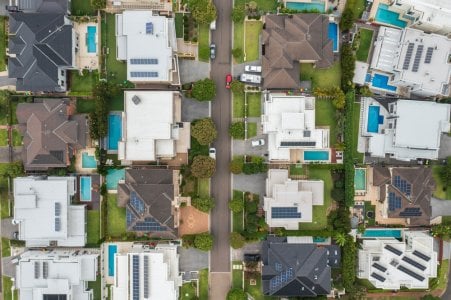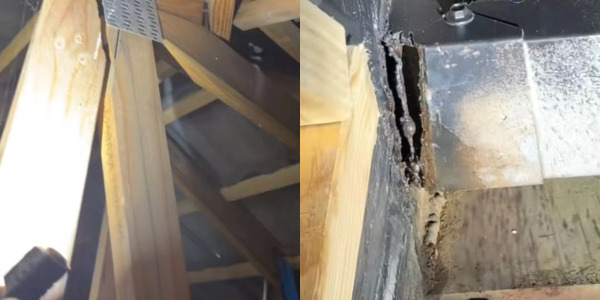Is your home a ‘ticking time bomb’? Millions of Aussies are at risk from serious building defects
By
Seia Ibanez
- Replies 7
The dream of owning a home in Australia has always been synonymous with security and comfort.
However, for millions of Australians, this dream is under threat as their homes may be harbouring hidden dangers.
Recent findings from the Australian Housing and Urban Research Institute (AHURI) have set off alarm bells, revealing that a staggering 70 per cent of the estimated 10.9 million homes across the country suffer from major building defects.
The research, led by Associate Professor Lyrian Daniel from the University of South Australia, challenges the long-held belief that Australian homes are built to last.
‘For many years in Australia, we’ve had a fairly laissez-faire approach to regulation in the construction sector when it comes to the quality of our housing,’ Dr Daniel said.

‘The notion that the free market will demand a certain level of quality—it will lead to high standards—simply doesn’t ring true. We need national leadership in this area—a strategy that ensures housing stock, whether it’s new, existing, owned or private rental, is of a good standard.’
Building inspector Zeher Khalil, founder of Site Inspection, echoed these concerns.
In his line of work, inspecting new and recently constructed homes, he finds at least one serious defect in every dwelling he examines.
‘We don’t categorise issues as minor or major—we look at whether the minimum Australian standards have been met,’ Khalil explained.
‘That’s all we’re expecting—not that a (tradesperson) has gone above and beyond, but that they’ve done the bare minimum required of them. And I’m telling you, not many have. I see non-compliant defects 100 per cent of the time.’
‘I’m talking about really serious issues that require the roof to be stripped out or an entire bathroom to be demolished,’ he added.
‘Given around 150,000 to 170,000 new homes are built each year, that’s a lot of “ticking time bombs” that will go off sooner rather than later.’
Khalil shares videos on social media of his encounters with defects in every home he checks.
Authorities in states like Victoria and New South Wales have begun to take action by naming and shaming serious offenders and issuing work rectification orders.
However, the problem is widespread and not confined to any one area or type of dwelling. From stand-alone houses to dense apartment complexes, from small operators to major builders, Khalil said defects are a common end-of-construction issue.
The situation is so dire that even luxury homes selling for millions are not immune to these defects.
‘Last week, I was in Sydney, and I inspected a home that was selling for $2.5 million,’ Khalil said.
‘Essentially, the whole thing was noncompliance. Roofing, waterproofing, water going into the kitchen, guttering, leaks…you name it.’
‘That’s a minimum of $100,000 to correct. Someone will have to allow for that. It’s a huge problem. And when you’re building a new home, what are you meant to do—expect you’ll have to pay more on top to fix problems or take the builder to court? It’s crazy.’

The mental health and wellbeing of those living with these issues cannot be overlooked.
‘There are implications for people’s mental health and wellbeing while living with these issues, so depression and anxiety and so on,’ Dr Daniel said.
‘There are a whole range of health issues that arise from mould, whether it’s respiratory disease or the exacerbation of asthma.’
‘But I think it’s really worth remembering that it’s not just new builds, but existing homes as well.’
Furthermore, AHURI research has found that, according to international standards set by the World Health Organisation, four out of five Australian homes are too cold during winter, which can exacerbate health issues like cardiovascular and respiratory diseases.
A study by the Australian Apartment Advocacy found that 60 per cent of new apartment units have serious problems, like unsafe balconies, cracked foundations, and ongoing water leaks.
‘In my view, the problem is so bad and so common because people have gotten away with it for so long,’ Khalil said.
When tradespeople are held responsible, they often face only minor consequences. Builders who are taken to court by frustrated owners often just close their business and claim they’re broke.
Khalil said stronger regulators are needed with real power, along with serious penalties and long-term consequences for those who make mistakes.
Dr Daniel agreed but added that real change would need national coordination, political bravery, and the ability to resist pressure from lobbyists.
 We invite you to share your experiences and thoughts on this pressing issue. Have you encountered building defects in your home? How have you dealt with them? Let us know in the comments below!
We invite you to share your experiences and thoughts on this pressing issue. Have you encountered building defects in your home? How have you dealt with them? Let us know in the comments below!
However, for millions of Australians, this dream is under threat as their homes may be harbouring hidden dangers.
Recent findings from the Australian Housing and Urban Research Institute (AHURI) have set off alarm bells, revealing that a staggering 70 per cent of the estimated 10.9 million homes across the country suffer from major building defects.
The research, led by Associate Professor Lyrian Daniel from the University of South Australia, challenges the long-held belief that Australian homes are built to last.
‘For many years in Australia, we’ve had a fairly laissez-faire approach to regulation in the construction sector when it comes to the quality of our housing,’ Dr Daniel said.

Millions of Aussies are at risk of major building defects, according to research. Credit: Shutterstock
‘The notion that the free market will demand a certain level of quality—it will lead to high standards—simply doesn’t ring true. We need national leadership in this area—a strategy that ensures housing stock, whether it’s new, existing, owned or private rental, is of a good standard.’
Building inspector Zeher Khalil, founder of Site Inspection, echoed these concerns.
In his line of work, inspecting new and recently constructed homes, he finds at least one serious defect in every dwelling he examines.
‘We don’t categorise issues as minor or major—we look at whether the minimum Australian standards have been met,’ Khalil explained.
‘That’s all we’re expecting—not that a (tradesperson) has gone above and beyond, but that they’ve done the bare minimum required of them. And I’m telling you, not many have. I see non-compliant defects 100 per cent of the time.’
‘I’m talking about really serious issues that require the roof to be stripped out or an entire bathroom to be demolished,’ he added.
‘Given around 150,000 to 170,000 new homes are built each year, that’s a lot of “ticking time bombs” that will go off sooner rather than later.’
Khalil shares videos on social media of his encounters with defects in every home he checks.
Authorities in states like Victoria and New South Wales have begun to take action by naming and shaming serious offenders and issuing work rectification orders.
However, the problem is widespread and not confined to any one area or type of dwelling. From stand-alone houses to dense apartment complexes, from small operators to major builders, Khalil said defects are a common end-of-construction issue.
The situation is so dire that even luxury homes selling for millions are not immune to these defects.
‘Last week, I was in Sydney, and I inspected a home that was selling for $2.5 million,’ Khalil said.
‘Essentially, the whole thing was noncompliance. Roofing, waterproofing, water going into the kitchen, guttering, leaks…you name it.’
‘That’s a minimum of $100,000 to correct. Someone will have to allow for that. It’s a huge problem. And when you’re building a new home, what are you meant to do—expect you’ll have to pay more on top to fix problems or take the builder to court? It’s crazy.’

Building inspector Zeher Khalil said he finds defects in every new home he checks. Credit: @siteinspections / TikTok
The mental health and wellbeing of those living with these issues cannot be overlooked.
‘There are implications for people’s mental health and wellbeing while living with these issues, so depression and anxiety and so on,’ Dr Daniel said.
‘There are a whole range of health issues that arise from mould, whether it’s respiratory disease or the exacerbation of asthma.’
‘But I think it’s really worth remembering that it’s not just new builds, but existing homes as well.’
Furthermore, AHURI research has found that, according to international standards set by the World Health Organisation, four out of five Australian homes are too cold during winter, which can exacerbate health issues like cardiovascular and respiratory diseases.
A study by the Australian Apartment Advocacy found that 60 per cent of new apartment units have serious problems, like unsafe balconies, cracked foundations, and ongoing water leaks.
‘In my view, the problem is so bad and so common because people have gotten away with it for so long,’ Khalil said.
When tradespeople are held responsible, they often face only minor consequences. Builders who are taken to court by frustrated owners often just close their business and claim they’re broke.
Khalil said stronger regulators are needed with real power, along with serious penalties and long-term consequences for those who make mistakes.
Dr Daniel agreed but added that real change would need national coordination, political bravery, and the ability to resist pressure from lobbyists.
Key Takeaways
- Australian Housing and Urban Research Institute research reveals 70 per cent of Australia's estimated 10.9 million homes have serious building defects.
- Building defects range from minor issues to serious structural faults and foundation cracking, posing significant risks to residents.
- Building inspector Zeher Khalil frequently finds non-compliant defects in newly constructed homes, suggesting a widespread problem in the building industry.
- Authorities have started naming and shaming serious offenders, but experts call for national coordination and stronger consequences for non-compliance to address the issue effectively.







